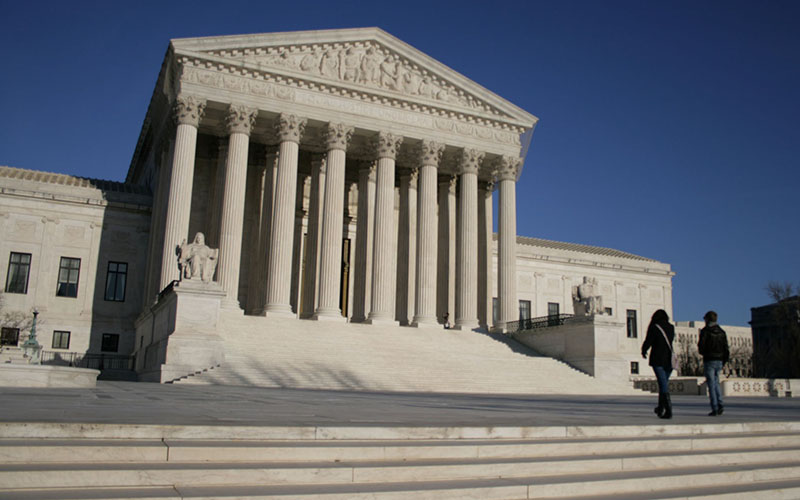
The Supreme Court said a Tucson police corporal who shot a woman during a call in 2010 could not be sued by the woman because his actions were reasonable under the circumstances – a decision critics called “troubling.” (Photo by Stephanie Snyder/Cronkite News)
WASHINGTON – The Supreme Court reversed a lower court Monday and said a Tucson police officer cannot be sued for shooting a woman who refused to drop a knife as she stood in her driveway.
The court took the unusual step of issuing its decision without holding a hearing on the case. It said University of Arizona Police Cpl. Andrew Kisela enjoyed immunity in the 2010 shooting of Amy Hughes because his actions did not clearly violate the law in a situation in which the officer had “mere seconds” to make a decision.
In a dissent, Justice Sonia Sotomayor called Kisela’s actions clearly unconstitutional. Sotomayor, joined by Justice Ruth Bader Ginsburg, said the court’s ruling “tells officers they can shoot first and think later, and it tells the public that palpably unreasonable conduct will go unpunished.”
An attorney for Hughes agreed that the decision is “troubling.”
“It’s a disappointing outcome and has troubling implications for police accountability,” said David Shapiro of the Roderick and Solange MacArthur Justice Center.
Calls seeking comment from the Arizona Attorney General’s Office, which represented Kisela, were not returned Monday.
The case began on May 21, 2010, when Kisela and Officer-in-Training Alex Garcia responded to a “welfare check” call on a woman who was hacking at a tree with a large kitchen knife and, according to one witness, looking like she was going to do “something crazy.” They were joined by Officer Lindsay Kunz.
The three officers saw Sharon Chadwick standing in the front yard of the house behind a 5-foot-tall chain-link fence. Hughes, who matched the description of the welfare-check subject, then walked out of the house, still holding the knife by her side.
In events that unfolded in less than a minute, the officers first rushed the fence, drawing their guns and demanding that Hughes drop the knife. They repeatedly told Hughes to drop the knife, but Chadwick claims she only heard the command given twice in quick succession.
Hughes walked toward Chadwick, demanding that she turn over $20 Hughes claimed she was owed. Chadwick went to her car to get the money, closely followed by Hughes.
Chadwick handed the money over and backed away from Hughes, but they were still within 5 feet of each other when Kisela said he saw Hughes raise the knife and he opened fire, striking her four times, according to court documents.
The other officers and Chadwick said they did not see Hughes raise the knife. Other witnesses said Hughes was holding the knife at her side, with the point down and the edge of the blade facing backwards, according to court documents.
After the shooting, the officers jumped the fence, handcuffed the wounded Hughes and called for medical aid.
Chadwick told officers after the shooting that Hughes had been diagnosed and medicated for bipolar disorder. She said she had managed Hughes’ behavior in the past, and that if the police had given her the chance she would have gotten Hughes to drop the knife.
Hughes filed suit in federal court, claiming Kisela violated her Fourth Amendment right by using excessive force. But a district court judge disagreed, saying the force used by Kisela was not “objectively unreasonable in light of all the relevant circumstances.”
A three-judge panel of the 9th U.S. Circuit Court reversed that decision, saying Kisela did not have a reason to believe that deadly force was necessary. He should have realized Hughes was mentally ill and diminished his use of force appropriately, the court said, adding that Hughes “had a constitutional right to walk down her driveway holding a knife without being shot.”
The state appealed to the Supreme Court, arguing that the decision to deny Kisela qualified immunity was at odds with virtually every other circuit court and the Supreme Court and ignored “the unpleasant and complicated facts that officers must evaluate in split-second decision-making.”
Hughes’ attorneys had argued that it is settled law that an officer can only shoot someone if they have reason to believe the suspect poses a threat of serious physical harm to the officer or others.
Even though testimony in the case presented “a tangled and inconsistent set of disputed recollections,” Hughes said the facts clearly show that Kisela used excessive force, a clearly established rights violation that means he should not receive qualified immunity.
The Supreme Court saw the case differently. It said that “even assuming that a Fourth Amendment violation occurred – a proposition that is not at all evident – on these facts Kisela was at least entitled to qualified immunity.”
“Kisela says he shot Hughes because, although the officers themselves were in no apparent danger, he believed she was a threat to Chadwick. Kisela had mere seconds to assess the potential danger to Chadwick,” the court said.
“This is far from an obvious case in which any competent officer would have known that shooting Hughes to protect Chadwick would violate the Fourth Amendment,” the justices wrote.
Sotomayor looked at the same facts and came to a different conclusion. She said Kisela should not enjoy immunity because he had no “legitimate interest justifying the use of deadly force against a woman who posed no objective threat of harm to officer or others, had committed no crime, and appeared calm and collected during the police encounter.”
Sotomayor called the decision part of a “disturbing trend” by the court, which increasingly sides with the police.
“Such a one-sided approach to qualified immunity transforms the doctrine into an absolute shield for law enforcement officers, gutting the deterrent effect of the Fourth Amendment,” she wrote.